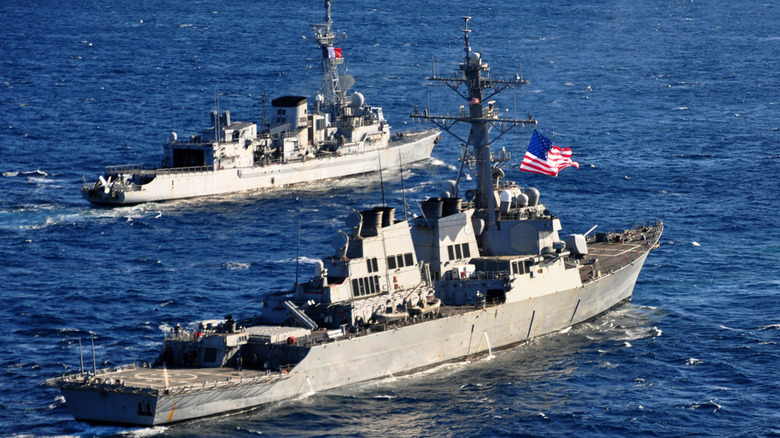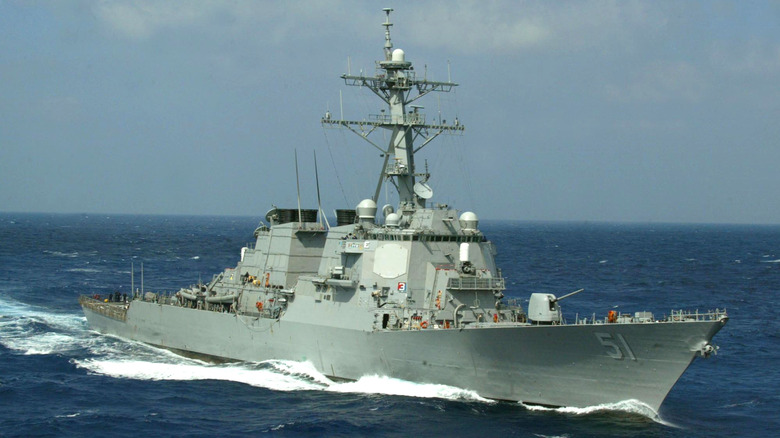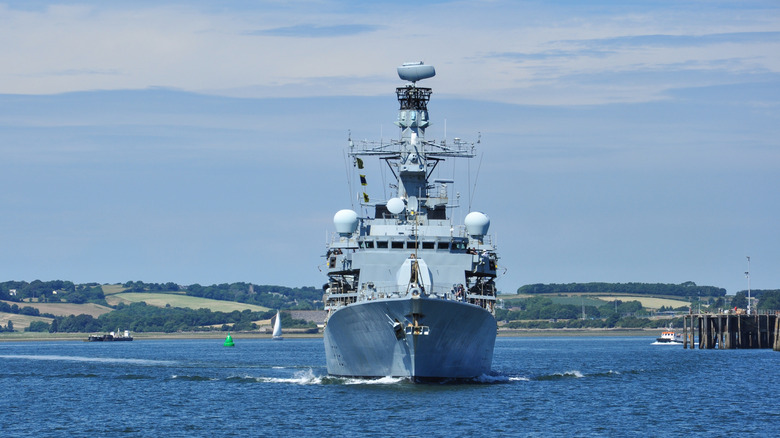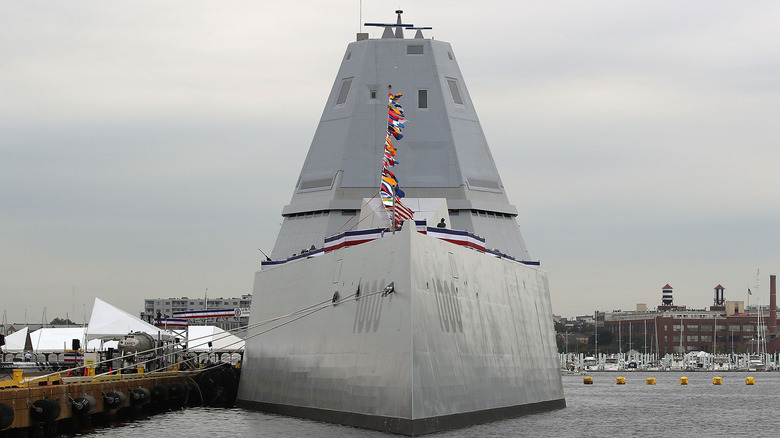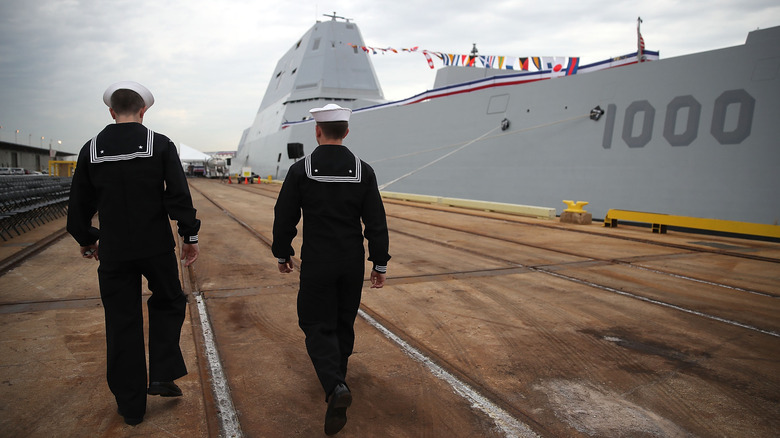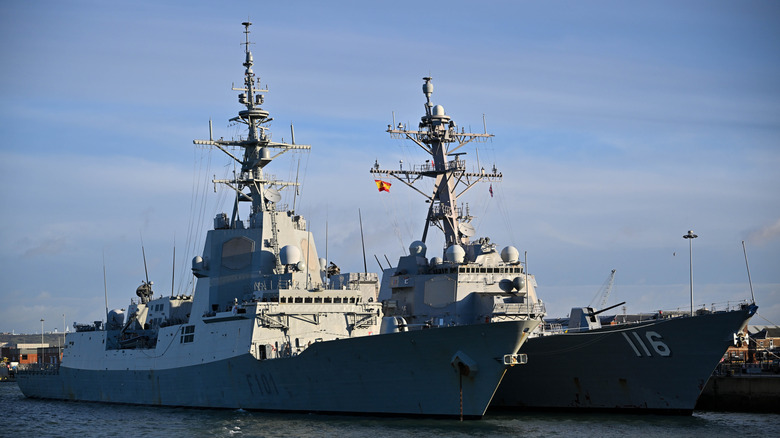Destroyer Vs. Frigate: What's The Difference Between These Warships?
Warships are among the biggest vessels in our oceans. For instance, the monstrous USS Gerald Ford, the first of its class of aircraft carriers, displaces around 100,000 tonnes and measures 1,106 feet long. Such ships will typically travel in a fleet, accompanied by a range of other types of warship. Two such types often deployed to help escort carriers on their travels are the frigate and the destroyer.
For those unfamiliar with naval vessels, it can be difficult to understand the differences between them. To clear up some of the confusion around the range of modern warships deployed around the world, let's turn the spotlight on two varieties in particular: the frigate and the destroyer.
Historically, the naval destroyer has been known for its offensive might, with a frigate being a lighter model. There's much more to consider than just that, though. In this article, we'll compare the size, the equipment, the intended role, and the fascinating history of these models.
The introduction of the frigate and destroyer
Over the course of the 16th and 17th centuries, the term frigate could be applied, according to Philip K. Allan in Naval History magazine, to "any lightly armed, fast, and maneuverable warship." There was no single definition, but these characteristics were common among them. They were smaller models built for light pursuit, escort, and defensive roles.
Allan dubs France's Medée, built in 1741, the first true frigate. It incorporated refinements such as stronger weaponry, as well as structural improvements that helped with performance. The mantra that came to define a frigate of its time, per Allan, was to "outrun any ship she could not defeat and defeat any ship she could not outrun."
The destroyer got its name as the initial craft were deployed by the British to hunt and neutralize the growing threat of torpedo boats (one example of such is pictured in the above vintage postcard), and they were thus called torpedo boat destroyers. Both before and during World War I, destroyers were developed with the size and range needed to serve in fleets with other naval vessels, and in the face of Germany's devastating submarine tactics later in the conflict, destroyers were tasked with defending allied craft.
The weaponry of a destroyer: Then and now
In 1910, U.S. Navy Lieutenant-Commander Yates Stirling Jr. deemed the destroyer to be, via U.S. Naval Institute Proceedings, "the night-watchman for the battleship."
Before the proliferation of armor-piercing missiles, torpedoes were among the deadliest weapons of the oceans, capable of sinking even the mightiest boats after being launched from the stealthy platform of a submarine beneath the waves, or a small and speedy torpedo boat. Early destroyers had to target these threats.
The first destroyers were armed with torpedoes and guns of varying weights. The first examples wielded by the United States were the steam-powered Bainbridge and Truxtun class of the early 20th century, which boasted three-inch and six-pound guns as well as eighteen-inch torpedo tubes.
Around a century later, the USS Arleigh Burke is a new variety of guided missile destroyer. The Arleigh Burke class were the first ships of their kind to feature the AEGIS system, which combines the AEGIS Ballistic Missile Defense and AEGIS Weapon System into an all-in-one combat system designed to detect threats and target foes.
The Arleigh Burke class, through a combination of MK46/50 torpedoes, SM-2MR missiles, Tomahawk cruise missiles, and more besides, can hit targets on land, sea, and air.
How the weaponry of a frigate compares
Historically, frigates, such as 1741's aforementioned Medée, were not themselves lacking on the offensive front – the top deck could house over two-dozen eight-pound guns. It was a far cry from some of the earlier small warships that were the predecessors to the frigate, the smallest of which in the Royal Navy in 1719 couldn't use some of their potential six-pound gun space on the bottom deck if the seas weren't calm.
In the modern age of guided missile destroyers, one potent frigate model — currently being developed for the British, Canadian, and Australian navies by BAE Systems – is the Type 26 frigate. In April 2024, BAE Systems Naval Ships MD Sir Simon Lister described the model to the UK Defence Journal as "an anti-submarine warfare frigate ... without doubt one of the best, if not the best anti-submarine warfare platforms in the world."
With planned access to the Phalanx CIWS, .50 machine guns, Sea Ceptor missiles, and planned capability for cruise missiles in its infrastructure, it's going to have considerable firepower, albeit with an overall offensive focus on one specific type of target.
A question of speed
Are frigates faster than destroyers? You might think that the answer would be a decisive yes, as they're typically lighter designs with less burden from ammunition supplies, and its initial patrol leanings would have also necessitated a certain need for speed. However, a destroyer's defensive capacities would be compromised if it was routinely outstripped by its targets.
Guinness World Records reports that the world's fastest destroyer was France's menacingly-named Le Terrible, which hit 45.25 knots in 1935. In comparison, the modern frigate the HMS Sutherland, which the Royal Navy declares to be its speediest in its fleet, is only capable of speeds of around 34 knots.
Therefore, it's difficult to say whether frigates or destroyers are quicker. The bigger and heavier destroyers can surprise by matching pace with smaller and lighter frigates. Even the United States' hefty USS Zumwalt class of destroyer can sail at 30 knots – more than capable of attaining the speed of frigates.
The crucial question of size
The size of a vehicle has a huge impact on its potential function. It's to be expected that a ship designed around the concept of maneuverability and speed would be small and potentially light, and this is generally the case with the frigate in comparison to the destroyer.
The size disparity, while varying a lot between the many different types of frigate and destroyer around the world, can be significant. The monstrous Zumwalt class of destroyers are 610 feet long and 80 feet wide. Its displacement is 15,995 metric tons, and it hosts 197 crew members.
The exceptionally large frigate that is the F126 project (the first model of its class is targeting completion in 2028), is set to have a crew of 114, displace approximately 11,000 tons, and measure 545 feet in length. It seems clear that the biggest destroyers will tend to trump the biggest frigates in size.
There are some important implications. As the Royal United Services Institute for Defence and Security Studies' Dr Sidharth Kaushal put it, via Naval Technology, the bigger destroyers can "more easily carry and generate the power for more powerful high-resolution radar and a larger number of vertical launch cells. They can thus provide theatre wide air and missile defense for forces such as a carrier battle group and typically serve this function."
Not so different after all
Frigates and destroyers evolved from a similar purpose: to eliminate threats from the likes of torpedo boats and submarines. Each has developed a sophisticated arsenal of weapons since their introduction, and revolutionary ships of both types have had huge influences on naval combat.
Both types of warship have a lot in common. Certain destroyers can match the pace of the historically speedy frigates, while some frigates have access to a range of weaponry found on destroyers. The Spanish Alvaro de Bazan frigate was "the first European ship with the Aegis anti-aircraft system," Navy Newsstand reported in 2005, "making it comparable to the destroyer [USS Mason, with which the Spanish model had conducted exercises two years prior]."
The line between the two is certainly blurred. A frigate may be more oriented for submarine defense and a destroyer for anti-air defense, but different models of each have different capacities for both.
